Yahoo's Telecommuting Policy: A Detailed Look at Pros, Cons, Impacts
VerifiedAdded on 2023/06/15
|6
|1441
|471
Report
AI Summary
This report examines the concept of telecommuting, exploring its advantages and disadvantages within organizations, particularly focusing on the difficulties in controlling and supervising remote work. It delves into the growing trend of telecommuting, highlighting benefits such as improved work-life balance and increased productivity, while also addressing challenges like supervision difficulties and potential social isolation. The report analyzes Yahoo's 2013 decision to end telecommuting, citing issues with collaboration, security risks, and inconsistent supervision as key factors. It concludes that while telecommuting offers benefits, organizations must carefully consider the nature of work, ICT implementation, and modifications to monitoring and security policies before adopting such practices, emphasizing the importance of balancing flexibility with effective management and security measures.

Yahoo
Pros & Cons of Telecommuting
11/29/2017
Pros & Cons of Telecommuting
11/29/2017
Paraphrase This Document
Need a fresh take? Get an instant paraphrase of this document with our AI Paraphraser
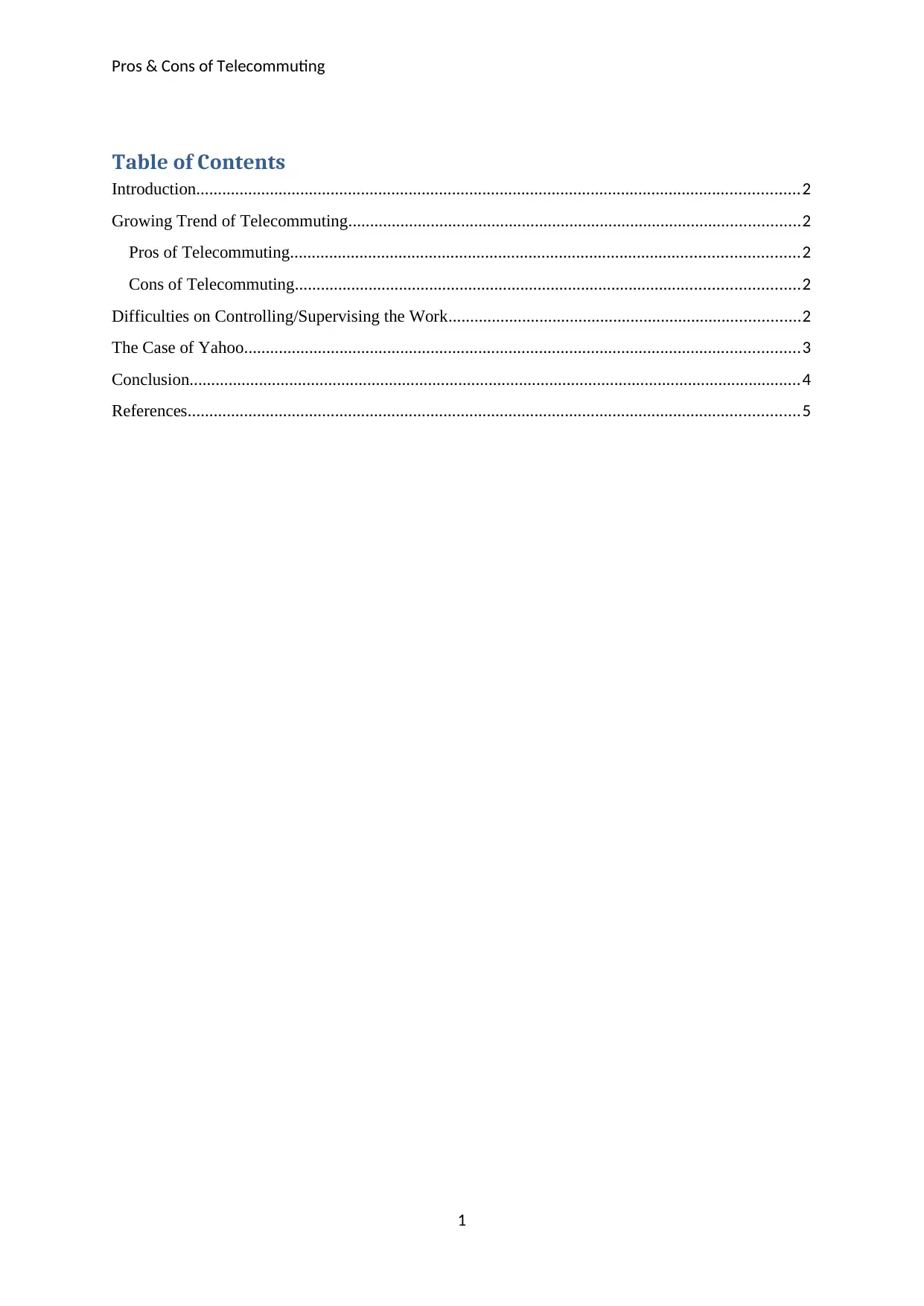
Pros & Cons of Telecommuting
Table of Contents
Introduction...........................................................................................................................................2
Growing Trend of Telecommuting........................................................................................................2
Pros of Telecommuting.....................................................................................................................2
Cons of Telecommuting....................................................................................................................2
Difficulties on Controlling/Supervising the Work.................................................................................2
The Case of Yahoo................................................................................................................................3
Conclusion.............................................................................................................................................4
References.............................................................................................................................................5
1
Table of Contents
Introduction...........................................................................................................................................2
Growing Trend of Telecommuting........................................................................................................2
Pros of Telecommuting.....................................................................................................................2
Cons of Telecommuting....................................................................................................................2
Difficulties on Controlling/Supervising the Work.................................................................................2
The Case of Yahoo................................................................................................................................3
Conclusion.............................................................................................................................................4
References.............................................................................................................................................5
1
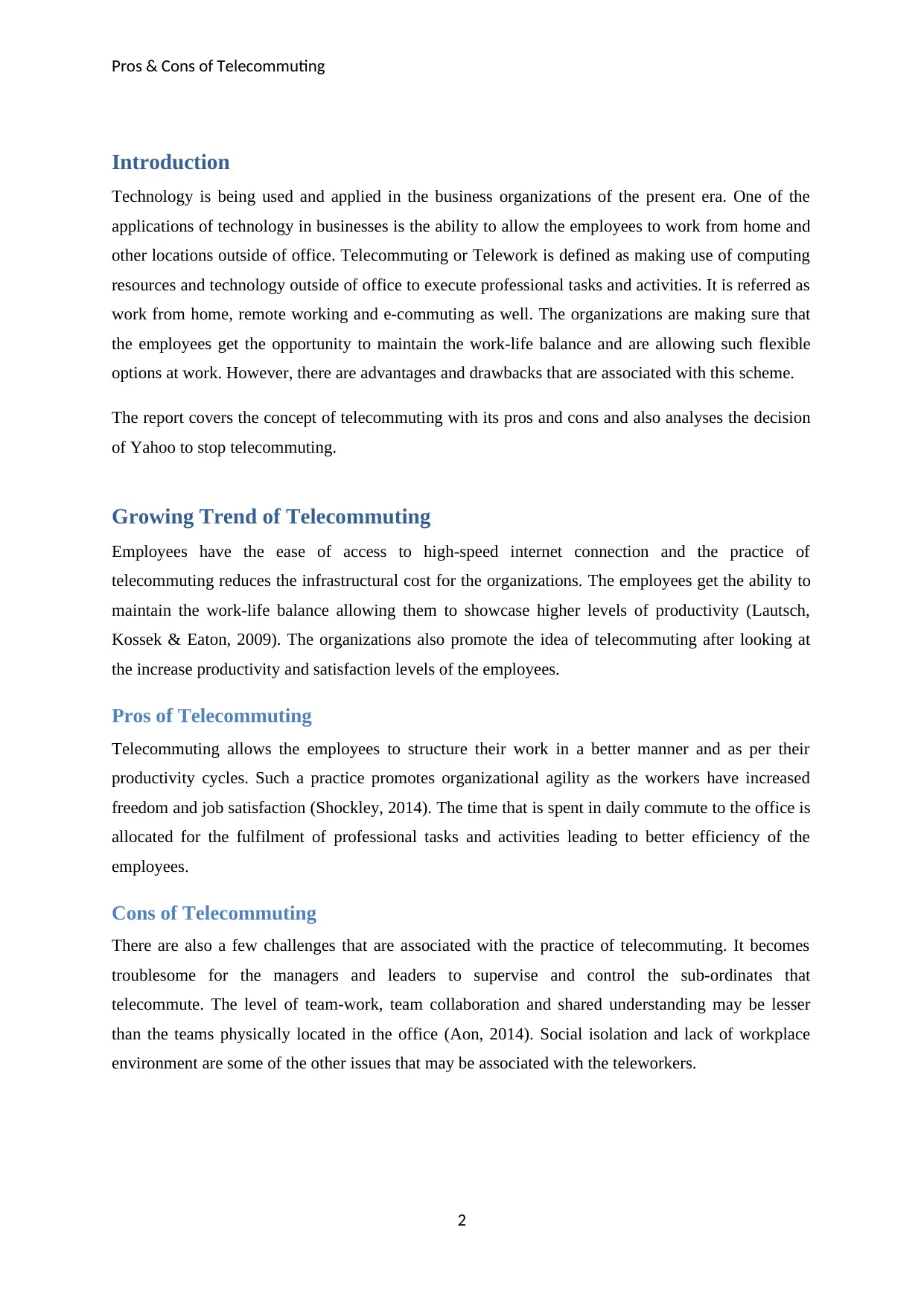
Pros & Cons of Telecommuting
Introduction
Technology is being used and applied in the business organizations of the present era. One of the
applications of technology in businesses is the ability to allow the employees to work from home and
other locations outside of office. Telecommuting or Telework is defined as making use of computing
resources and technology outside of office to execute professional tasks and activities. It is referred as
work from home, remote working and e-commuting as well. The organizations are making sure that
the employees get the opportunity to maintain the work-life balance and are allowing such flexible
options at work. However, there are advantages and drawbacks that are associated with this scheme.
The report covers the concept of telecommuting with its pros and cons and also analyses the decision
of Yahoo to stop telecommuting.
Growing Trend of Telecommuting
Employees have the ease of access to high-speed internet connection and the practice of
telecommuting reduces the infrastructural cost for the organizations. The employees get the ability to
maintain the work-life balance allowing them to showcase higher levels of productivity (Lautsch,
Kossek & Eaton, 2009). The organizations also promote the idea of telecommuting after looking at
the increase productivity and satisfaction levels of the employees.
Pros of Telecommuting
Telecommuting allows the employees to structure their work in a better manner and as per their
productivity cycles. Such a practice promotes organizational agility as the workers have increased
freedom and job satisfaction (Shockley, 2014). The time that is spent in daily commute to the office is
allocated for the fulfilment of professional tasks and activities leading to better efficiency of the
employees.
Cons of Telecommuting
There are also a few challenges that are associated with the practice of telecommuting. It becomes
troublesome for the managers and leaders to supervise and control the sub-ordinates that
telecommute. The level of team-work, team collaboration and shared understanding may be lesser
than the teams physically located in the office (Aon, 2014). Social isolation and lack of workplace
environment are some of the other issues that may be associated with the teleworkers.
2
Introduction
Technology is being used and applied in the business organizations of the present era. One of the
applications of technology in businesses is the ability to allow the employees to work from home and
other locations outside of office. Telecommuting or Telework is defined as making use of computing
resources and technology outside of office to execute professional tasks and activities. It is referred as
work from home, remote working and e-commuting as well. The organizations are making sure that
the employees get the opportunity to maintain the work-life balance and are allowing such flexible
options at work. However, there are advantages and drawbacks that are associated with this scheme.
The report covers the concept of telecommuting with its pros and cons and also analyses the decision
of Yahoo to stop telecommuting.
Growing Trend of Telecommuting
Employees have the ease of access to high-speed internet connection and the practice of
telecommuting reduces the infrastructural cost for the organizations. The employees get the ability to
maintain the work-life balance allowing them to showcase higher levels of productivity (Lautsch,
Kossek & Eaton, 2009). The organizations also promote the idea of telecommuting after looking at
the increase productivity and satisfaction levels of the employees.
Pros of Telecommuting
Telecommuting allows the employees to structure their work in a better manner and as per their
productivity cycles. Such a practice promotes organizational agility as the workers have increased
freedom and job satisfaction (Shockley, 2014). The time that is spent in daily commute to the office is
allocated for the fulfilment of professional tasks and activities leading to better efficiency of the
employees.
Cons of Telecommuting
There are also a few challenges that are associated with the practice of telecommuting. It becomes
troublesome for the managers and leaders to supervise and control the sub-ordinates that
telecommute. The level of team-work, team collaboration and shared understanding may be lesser
than the teams physically located in the office (Aon, 2014). Social isolation and lack of workplace
environment are some of the other issues that may be associated with the teleworkers.
2
⊘ This is a preview!⊘
Do you want full access?
Subscribe today to unlock all pages.

Trusted by 1+ million students worldwide
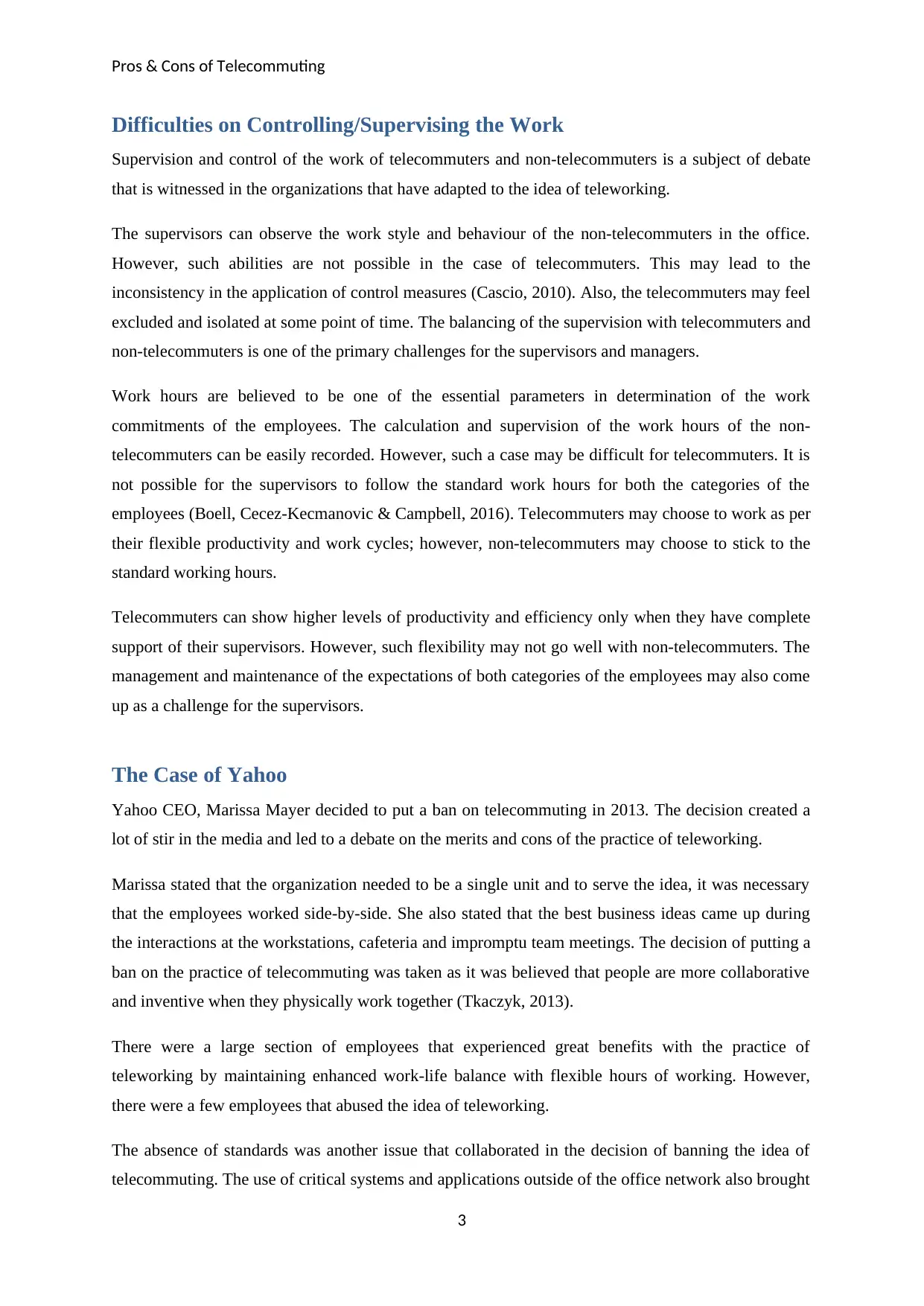
Pros & Cons of Telecommuting
Difficulties on Controlling/Supervising the Work
Supervision and control of the work of telecommuters and non-telecommuters is a subject of debate
that is witnessed in the organizations that have adapted to the idea of teleworking.
The supervisors can observe the work style and behaviour of the non-telecommuters in the office.
However, such abilities are not possible in the case of telecommuters. This may lead to the
inconsistency in the application of control measures (Cascio, 2010). Also, the telecommuters may feel
excluded and isolated at some point of time. The balancing of the supervision with telecommuters and
non-telecommuters is one of the primary challenges for the supervisors and managers.
Work hours are believed to be one of the essential parameters in determination of the work
commitments of the employees. The calculation and supervision of the work hours of the non-
telecommuters can be easily recorded. However, such a case may be difficult for telecommuters. It is
not possible for the supervisors to follow the standard work hours for both the categories of the
employees (Boell, Cecez-Kecmanovic & Campbell, 2016). Telecommuters may choose to work as per
their flexible productivity and work cycles; however, non-telecommuters may choose to stick to the
standard working hours.
Telecommuters can show higher levels of productivity and efficiency only when they have complete
support of their supervisors. However, such flexibility may not go well with non-telecommuters. The
management and maintenance of the expectations of both categories of the employees may also come
up as a challenge for the supervisors.
The Case of Yahoo
Yahoo CEO, Marissa Mayer decided to put a ban on telecommuting in 2013. The decision created a
lot of stir in the media and led to a debate on the merits and cons of the practice of teleworking.
Marissa stated that the organization needed to be a single unit and to serve the idea, it was necessary
that the employees worked side-by-side. She also stated that the best business ideas came up during
the interactions at the workstations, cafeteria and impromptu team meetings. The decision of putting a
ban on the practice of telecommuting was taken as it was believed that people are more collaborative
and inventive when they physically work together (Tkaczyk, 2013).
There were a large section of employees that experienced great benefits with the practice of
teleworking by maintaining enhanced work-life balance with flexible hours of working. However,
there were a few employees that abused the idea of teleworking.
The absence of standards was another issue that collaborated in the decision of banning the idea of
telecommuting. The use of critical systems and applications outside of the office network also brought
3
Difficulties on Controlling/Supervising the Work
Supervision and control of the work of telecommuters and non-telecommuters is a subject of debate
that is witnessed in the organizations that have adapted to the idea of teleworking.
The supervisors can observe the work style and behaviour of the non-telecommuters in the office.
However, such abilities are not possible in the case of telecommuters. This may lead to the
inconsistency in the application of control measures (Cascio, 2010). Also, the telecommuters may feel
excluded and isolated at some point of time. The balancing of the supervision with telecommuters and
non-telecommuters is one of the primary challenges for the supervisors and managers.
Work hours are believed to be one of the essential parameters in determination of the work
commitments of the employees. The calculation and supervision of the work hours of the non-
telecommuters can be easily recorded. However, such a case may be difficult for telecommuters. It is
not possible for the supervisors to follow the standard work hours for both the categories of the
employees (Boell, Cecez-Kecmanovic & Campbell, 2016). Telecommuters may choose to work as per
their flexible productivity and work cycles; however, non-telecommuters may choose to stick to the
standard working hours.
Telecommuters can show higher levels of productivity and efficiency only when they have complete
support of their supervisors. However, such flexibility may not go well with non-telecommuters. The
management and maintenance of the expectations of both categories of the employees may also come
up as a challenge for the supervisors.
The Case of Yahoo
Yahoo CEO, Marissa Mayer decided to put a ban on telecommuting in 2013. The decision created a
lot of stir in the media and led to a debate on the merits and cons of the practice of teleworking.
Marissa stated that the organization needed to be a single unit and to serve the idea, it was necessary
that the employees worked side-by-side. She also stated that the best business ideas came up during
the interactions at the workstations, cafeteria and impromptu team meetings. The decision of putting a
ban on the practice of telecommuting was taken as it was believed that people are more collaborative
and inventive when they physically work together (Tkaczyk, 2013).
There were a large section of employees that experienced great benefits with the practice of
teleworking by maintaining enhanced work-life balance with flexible hours of working. However,
there were a few employees that abused the idea of teleworking.
The absence of standards was another issue that collaborated in the decision of banning the idea of
telecommuting. The use of critical systems and applications outside of the office network also brought
3
Paraphrase This Document
Need a fresh take? Get an instant paraphrase of this document with our AI Paraphraser
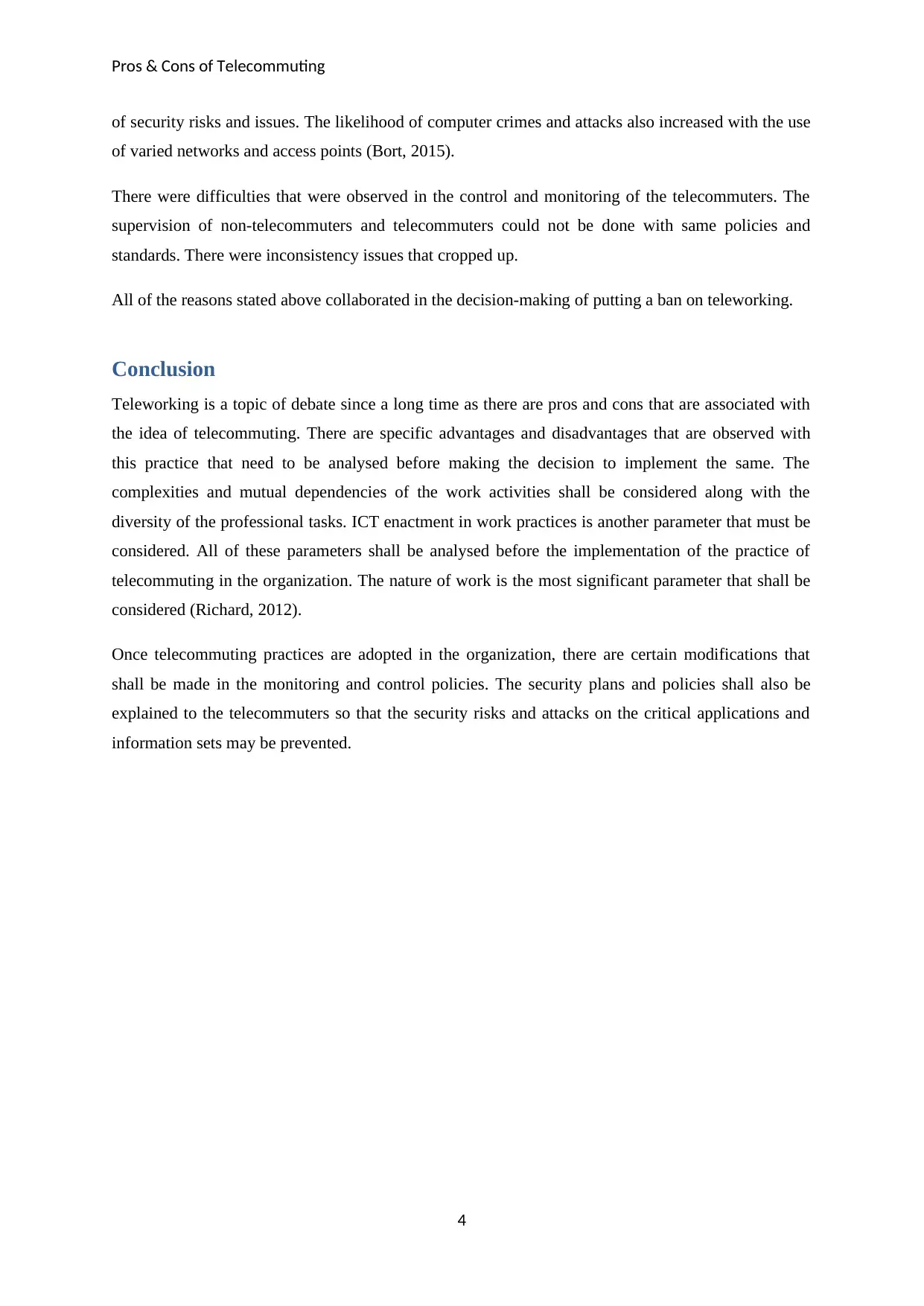
Pros & Cons of Telecommuting
of security risks and issues. The likelihood of computer crimes and attacks also increased with the use
of varied networks and access points (Bort, 2015).
There were difficulties that were observed in the control and monitoring of the telecommuters. The
supervision of non-telecommuters and telecommuters could not be done with same policies and
standards. There were inconsistency issues that cropped up.
All of the reasons stated above collaborated in the decision-making of putting a ban on teleworking.
Conclusion
Teleworking is a topic of debate since a long time as there are pros and cons that are associated with
the idea of telecommuting. There are specific advantages and disadvantages that are observed with
this practice that need to be analysed before making the decision to implement the same. The
complexities and mutual dependencies of the work activities shall be considered along with the
diversity of the professional tasks. ICT enactment in work practices is another parameter that must be
considered. All of these parameters shall be analysed before the implementation of the practice of
telecommuting in the organization. The nature of work is the most significant parameter that shall be
considered (Richard, 2012).
Once telecommuting practices are adopted in the organization, there are certain modifications that
shall be made in the monitoring and control policies. The security plans and policies shall also be
explained to the telecommuters so that the security risks and attacks on the critical applications and
information sets may be prevented.
4
of security risks and issues. The likelihood of computer crimes and attacks also increased with the use
of varied networks and access points (Bort, 2015).
There were difficulties that were observed in the control and monitoring of the telecommuters. The
supervision of non-telecommuters and telecommuters could not be done with same policies and
standards. There were inconsistency issues that cropped up.
All of the reasons stated above collaborated in the decision-making of putting a ban on teleworking.
Conclusion
Teleworking is a topic of debate since a long time as there are pros and cons that are associated with
the idea of telecommuting. There are specific advantages and disadvantages that are observed with
this practice that need to be analysed before making the decision to implement the same. The
complexities and mutual dependencies of the work activities shall be considered along with the
diversity of the professional tasks. ICT enactment in work practices is another parameter that must be
considered. All of these parameters shall be analysed before the implementation of the practice of
telecommuting in the organization. The nature of work is the most significant parameter that shall be
considered (Richard, 2012).
Once telecommuting practices are adopted in the organization, there are certain modifications that
shall be made in the monitoring and control policies. The security plans and policies shall also be
explained to the telecommuters so that the security risks and attacks on the critical applications and
information sets may be prevented.
4
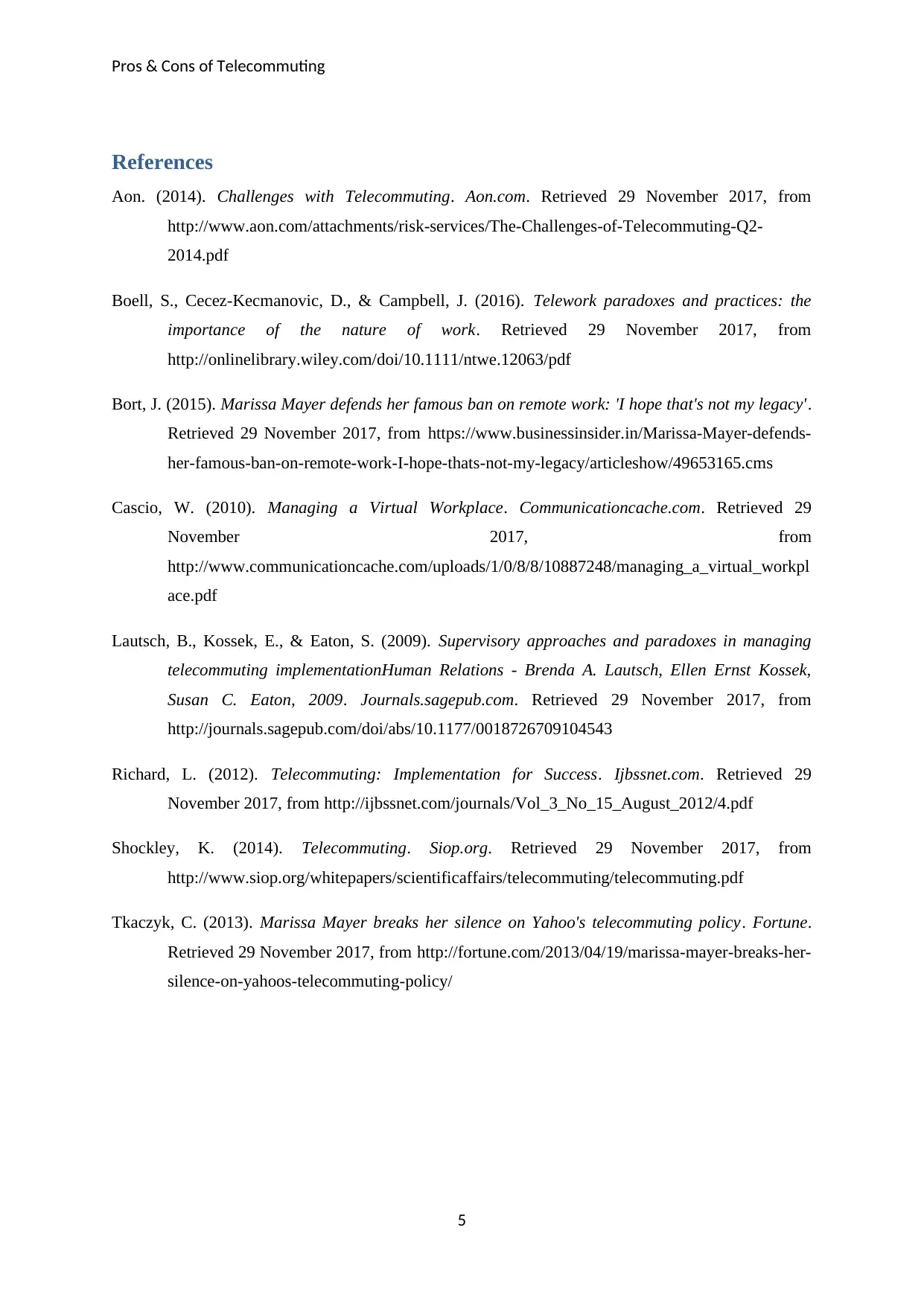
Pros & Cons of Telecommuting
References
Aon. (2014). Challenges with Telecommuting. Aon.com. Retrieved 29 November 2017, from
http://www.aon.com/attachments/risk-services/The-Challenges-of-Telecommuting-Q2-
2014.pdf
Boell, S., Cecez-Kecmanovic, D., & Campbell, J. (2016). Telework paradoxes and practices: the
importance of the nature of work. Retrieved 29 November 2017, from
http://onlinelibrary.wiley.com/doi/10.1111/ntwe.12063/pdf
Bort, J. (2015). Marissa Mayer defends her famous ban on remote work: 'I hope that's not my legacy'.
Retrieved 29 November 2017, from https://www.businessinsider.in/Marissa-Mayer-defends-
her-famous-ban-on-remote-work-I-hope-thats-not-my-legacy/articleshow/49653165.cms
Cascio, W. (2010). Managing a Virtual Workplace. Communicationcache.com. Retrieved 29
November 2017, from
http://www.communicationcache.com/uploads/1/0/8/8/10887248/managing_a_virtual_workpl
ace.pdf
Lautsch, B., Kossek, E., & Eaton, S. (2009). Supervisory approaches and paradoxes in managing
telecommuting implementationHuman Relations - Brenda A. Lautsch, Ellen Ernst Kossek,
Susan C. Eaton, 2009. Journals.sagepub.com. Retrieved 29 November 2017, from
http://journals.sagepub.com/doi/abs/10.1177/0018726709104543
Richard, L. (2012). Telecommuting: Implementation for Success. Ijbssnet.com. Retrieved 29
November 2017, from http://ijbssnet.com/journals/Vol_3_No_15_August_2012/4.pdf
Shockley, K. (2014). Telecommuting. Siop.org. Retrieved 29 November 2017, from
http://www.siop.org/whitepapers/scientificaffairs/telecommuting/telecommuting.pdf
Tkaczyk, C. (2013). Marissa Mayer breaks her silence on Yahoo's telecommuting policy. Fortune.
Retrieved 29 November 2017, from http://fortune.com/2013/04/19/marissa-mayer-breaks-her-
silence-on-yahoos-telecommuting-policy/
5
References
Aon. (2014). Challenges with Telecommuting. Aon.com. Retrieved 29 November 2017, from
http://www.aon.com/attachments/risk-services/The-Challenges-of-Telecommuting-Q2-
2014.pdf
Boell, S., Cecez-Kecmanovic, D., & Campbell, J. (2016). Telework paradoxes and practices: the
importance of the nature of work. Retrieved 29 November 2017, from
http://onlinelibrary.wiley.com/doi/10.1111/ntwe.12063/pdf
Bort, J. (2015). Marissa Mayer defends her famous ban on remote work: 'I hope that's not my legacy'.
Retrieved 29 November 2017, from https://www.businessinsider.in/Marissa-Mayer-defends-
her-famous-ban-on-remote-work-I-hope-thats-not-my-legacy/articleshow/49653165.cms
Cascio, W. (2010). Managing a Virtual Workplace. Communicationcache.com. Retrieved 29
November 2017, from
http://www.communicationcache.com/uploads/1/0/8/8/10887248/managing_a_virtual_workpl
ace.pdf
Lautsch, B., Kossek, E., & Eaton, S. (2009). Supervisory approaches and paradoxes in managing
telecommuting implementationHuman Relations - Brenda A. Lautsch, Ellen Ernst Kossek,
Susan C. Eaton, 2009. Journals.sagepub.com. Retrieved 29 November 2017, from
http://journals.sagepub.com/doi/abs/10.1177/0018726709104543
Richard, L. (2012). Telecommuting: Implementation for Success. Ijbssnet.com. Retrieved 29
November 2017, from http://ijbssnet.com/journals/Vol_3_No_15_August_2012/4.pdf
Shockley, K. (2014). Telecommuting. Siop.org. Retrieved 29 November 2017, from
http://www.siop.org/whitepapers/scientificaffairs/telecommuting/telecommuting.pdf
Tkaczyk, C. (2013). Marissa Mayer breaks her silence on Yahoo's telecommuting policy. Fortune.
Retrieved 29 November 2017, from http://fortune.com/2013/04/19/marissa-mayer-breaks-her-
silence-on-yahoos-telecommuting-policy/
5
⊘ This is a preview!⊘
Do you want full access?
Subscribe today to unlock all pages.

Trusted by 1+ million students worldwide
1 out of 6
Related Documents
Your All-in-One AI-Powered Toolkit for Academic Success.
+13062052269
info@desklib.com
Available 24*7 on WhatsApp / Email
![[object Object]](/_next/static/media/star-bottom.7253800d.svg)
Unlock your academic potential
Copyright © 2020–2025 A2Z Services. All Rights Reserved. Developed and managed by ZUCOL.





